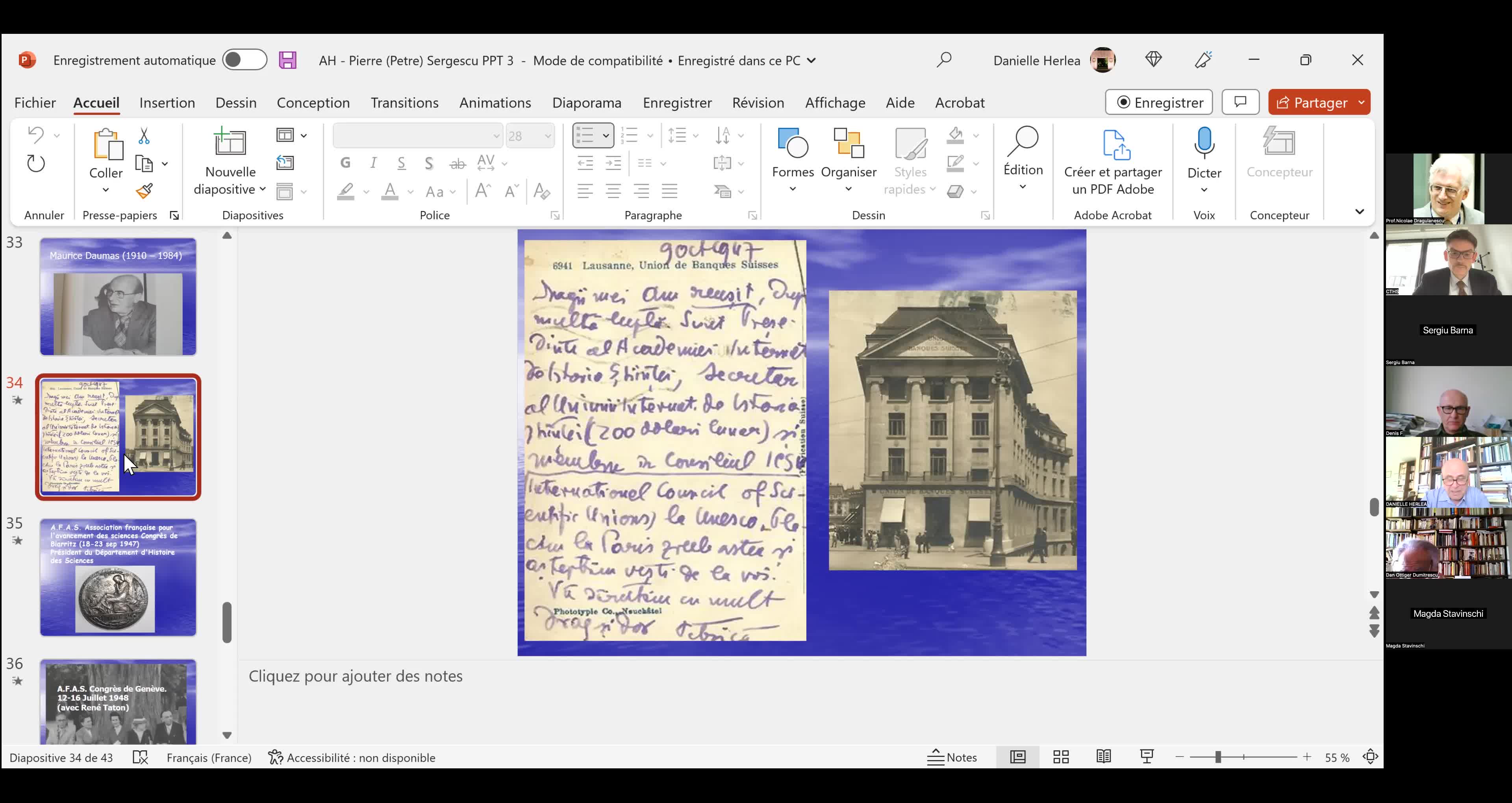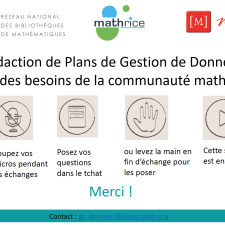Notice
Mike Boyle - Nonnegative matrices : Perron Frobenius theory and related algebra (Part 2)
- document 1 document 2 document 3
- niveau 1 niveau 2 niveau 3
Descriptif
Lecture I. I’ll give a complete elementary presentation of the essential features of the Perron Frobenius theory of nonnegative matrices for the central case of primitive matrices (the "Perron" part). (The "Frobenius" part, for irreducible matrices, and finally the case for general nonnegative matrices, will be described, with proofs left to accompanying notes.) For integer matrices we’ll relate "Perron numbers" to this and Mahler measures. Lecture II. I’ll describe how the Perron-Frobenius theory generalizes (and fails to generalize) to 1,2,... x 1,2,... nonnegative matrices. Lecture III. We’ll see the simple, potent formalism by which a certain zeta function can be associated to a nonnegative matrix, and its relation to the nonzero spectrum of the matrix, and how polynomial matrices can be used in this setting for constructions and conciseness. Lecture IV. We’ll describe a natural algebraic equivalence relation on finite square matrices over a semiring (such as Z, Z_+, R, ... ) which refines the nonzero spectrum and is related to K-theory.
Thème
Documentation
Liens
Dans la même collection
-
-
-
Alexander Gorodnik - Diophantine approximation and flows on homogeneous spaces (Part 1)
GORODNIK Alexander
The fundamental problem in the theory of Diophantine approximation is to understand how well points in the Euclidean space can be approximated by rational vectors with given bounds on
-
-
Alexander Gorodnik - Diophantine approximation and flows on homogeneous spaces (Part 3)
The fundamental problem in the theory of Diophantine approximation is to understand how well points in the Euclidean space can be approximated by rational vectors with given bounds on
-
-
Alexander Gorodnik - Diophantine approximation and flows on homogeneous spaces (Part 2)
The fundamental problem in the theory of Diophantine approximation is to understand how well points in the Euclidean space can be approximated by rational vectors with given bounds on
-
-
-
Christiane Frougny - Systèmes de numération et automates (Part 1)
FROUGNY Christiane
Automates finis et langages rationnels de mots finis • Automates finis et mots infinis • Systèmes de numération à base réelle • Nombres de Pisot, nombres de Parry et nombres de Perron • Systèmes
-
Karma Dajani - An introduction to Ergodic Theory of Numbers (Part 3)
In this course we give an introduction to the ergodic theory behind common number expansions, like expansions to integer and non-integer bases, Luroth series and continued fraction expansion.
-
Avec les mêmes intervenants et intervenantes
-
Mike Boyle - Nonnegative matrices : Perron Frobenius theory and related algebra (Part 4)
BOYLE Mike
Lecture I. I’ll give a complete elementary presentation of the essential features of the Perron Frobenius theory of nonnegative matrices for the central case of primitive matrices (the "Perron"
-
Mike Boyle - Nonnegative matrices : Perron Frobenius theory and related algebra (Part 1)
BOYLE Mike
Lecture I. I’ll give a complete elementary presentation of the essential features of the Perron Frobenius theory of nonnegative matrices for the central case of primitive matrices (the "Perron"
Sur le même thème
-
"Le mathématicien Petre (Pierre) Sergescu, historien des sciences, personnalité du XXe siècle"
HERLéA Alexandre
Alexandre HERLEA est membre de la section « Sciences, histoire des sciences et des techniques et archéologie industrielle » du CTHS. Professeur émérite des universités, membre effectif de l'Académie
-
Webinaire sur la rédaction des PGD
LOUVET Violaine
Rédaction des Plans de Gestion de Données (PGD) sous l’angle des besoins de la communauté mathématique.
-
Alexandre Booms : « Usage de matériel pédagogique adapté en géométrie : une transposition à interro…
« Usage de matériel pédagogique adapté en géométrie : une transposition à interroger ». Alexandre Booms, doctorant (Université de Reims Champagne-Ardenne - Cérep UR 4692)
-
D. Semola - Boundary regularity and stability under lower Ricci bounds
SEMOLA Daniele
The theory of non smooth spaces with lower Ricci Curvature bounds has undergone huge developments in the last thirty years. On the one hand the impetus came from Gromov’s precompactness theorem
-
D. Stern - Harmonic map methods in spectral geometry
STERN Daniel
Over the last fifty years, the problem of finding sharp upper bounds for area-normalized Laplacian eigenvalues on closed surfaces has attracted the attention of many geometers, due in part to
-
R. Bamler - Compactness and partial regularity theory of Ricci flows in higher dimensions
BAMLER Richard H.
We present a new compactness theory of Ricci flows. This theory states that any sequence of Ricci flows that is pointed in an appropriate sense, subsequentially converges to a synthetic flow.
-
P. Burkhardt - Pointwise lower scalar curvature bounds for C0 metrics via regularizing Ricci flow
BURKHARDT-GUIM Paula
We propose a class of local definitions of weak lower scalar curvature bounds that is well defined for C0 metrics. We show the following: that our definitions are stable under greater-than-second
-
C. Li - Classifying sufficiently connected PSC manifolds in 4 and 5 dimensions
LI Chao
In this talk, I will discuss some recent developments on the topology of closed manifolds admitting Riemannian metrics of positive scalar curvature. In particular, we will prove if a closed PSC
-
T. Ozuch - Noncollapsed degeneration and desingularization of Einstein 4-manifolds
OZUCH Tristan
We study the noncollapsed singularity formation of Einstein 4-manifolds. We prove that any smooth Einstein 4-manifold close to a singular one in a mere Gromov-Hausdorff (GH) sense is the result
-
D. Tewodrose - Limits of Riemannian manifolds satisfying a uniform Kato condition
TEWODROSE David
Presentation of a joint work with G. Carron and I. Mondello where we study Kato limit spaces.
-
Y. Lai - A family of 3d steady gradient Ricci solitons that are flying wings
LAI Yi
We find a family of 3d steady gradient Ricci solitons that are flying wings. This verifies a conjecture by Hamilton. For a 3d flying wing, we show that the scalar curvature does not vanish at
-
A. Mondino - Time-like Ricci curvature bounds via optimal transport
MONDINO Andrea
The goal of the talk is to present a recent work in collaboration with Cavalletti (SISSA) on optimal transport in Lorentzian synthetic spaces. The aim is to set up a “Lorentzian analog” of the



























